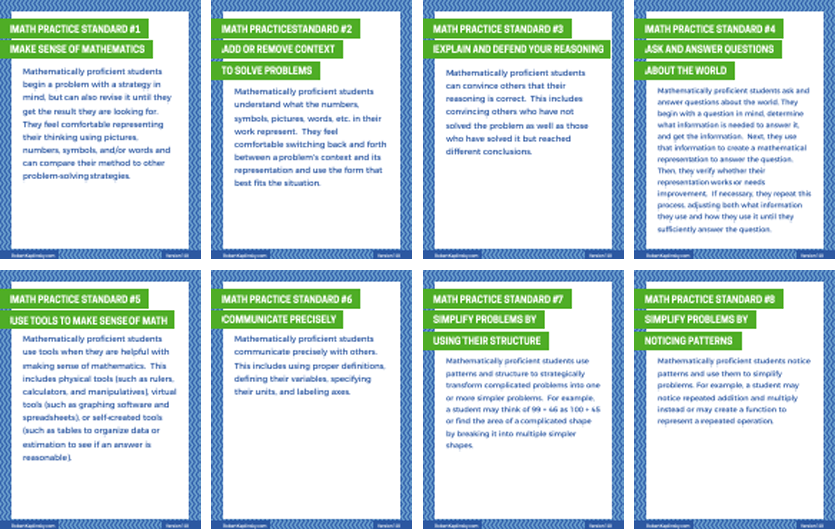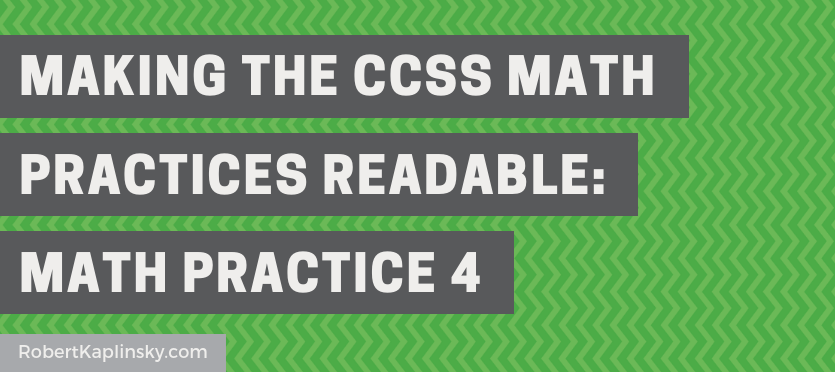This is the fourth of an eight blog post series where I’ll attempt to make a version of each of the Common Core State Standards’ Math Practices that educators, parents, and students can all understand. Simply put, the Math Practices are really tough to make sense of, which means that few educators have read them in full paragraph form and even fewer confidently understand them.
- My guiding principle comes from Antoine de Saint Exupéry who said “perfection is attained not when there is nothing more to add, but when there is nothing more to remove.” Certainly I could always add more details, but my goal is to make each standard as succinct as realistically possible and stop.
- I will make significant changes while still preserving what I believe to be each standard’s essence.
- I’ll also copy and paste the official math practice for comparison.
- I’ll add notes to explain my reasoning.
I realize that inevitably my version will also be flawed. Mainly I’m just curious to see if I can do any better. Thanks in advance for leaving me constructive criticism in the comments below so I can improve them.

Math Practice 4: Ask and answer questions about the world.
Mathematically proficient students ask and answer questions about the world. They begin with a question in mind, determine what information is needed to answer it, and get the information. Next, they use that information to create a mathematical representation to answer the question. Then, they verify whether their representation works or needs improvement. If necessary, they repeat this process, adjusting both what information they use and how they use it until they sufficiently answer the question.
Math Practice 4: Model with mathematics.
Mathematically proficient students can apply the mathematics they know to solve problems arising in everyday life, society, and the workplace. In early grades, this might be as simple as writing an addition equation to describe a situation. In middle grades, a student might apply proportional reasoning to plan a school event or analyze a problem in the community. By high school, a student might use geometry to solve a design problem or use a function to describe how one quantity of interest depends on another. Mathematically proficient students who can apply what they know are comfortable making assumptions and approximations to simplify a complicated situation, realizing that these may need revision later. They are able to identify important quantities in a practical situation and map their relationships using such tools as diagrams, two-way tables, graphs, flowcharts and formulas. They can analyze those relationships mathematically to draw conclusions. They routinely interpret their mathematical results in the context of the situation and reflect on whether the results make sense, possibly improving the model if it has not served its purpose.
- This was the most tricky standard for me to write and by far the longest. It was very hard for me to stick to my guiding principle of “perfection is attained not when there is nothing more to add, but when there is nothing more to remove.” For example, I wanted to add examples of what math modeling could look like, but didn’t.
- I went back and forth about whether to include “about the world” in the first sentence. On the one hand, it doesn’t necessarily have to be about the world. On the other hand, if I don’t add it, then it sounds like anytime you use math to answer questions, it is math modeling.
- As much as I believe in the importance of mathematical modeling, I believe that it is absolutely essential to take the word “model” out of the title if we want people to understand it. I know that will seem blasphemous to some people, but my goal is to make a version that educators, parents, and students can all understand. If we include the word model, it will continue to be misunderstood. So, while this standard is still about mathematical modeling, I chose not to call it that.


What is the difference between Practice 2 and 4 at the elementary level?
So I think the differences are the same at all grade levels but to me, 2 is about understanding where the numbers and symbols you use come from and being able to go back and forth between the context and the numbers.
With 4, you very likely use 2 but essentially you are trying to ask and answer questions about the world. In doing 4, you probably use 1, 2, 3, and others. So I can see where they get all mixed up. Does that help at all?